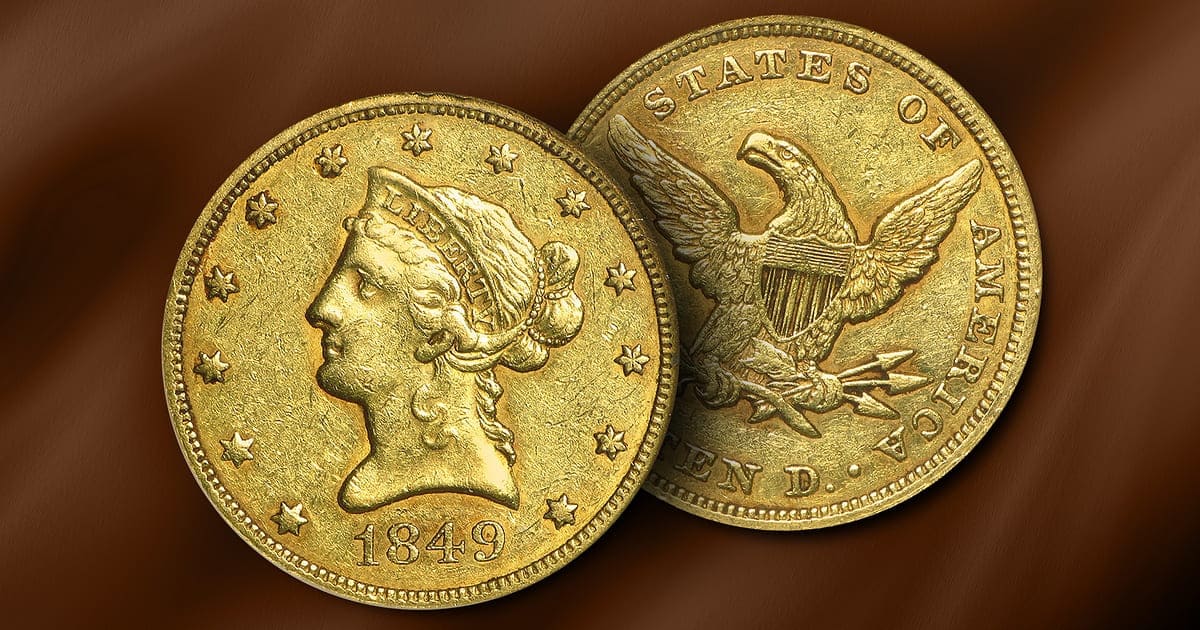
Learn About Moffat – Humbert
Due to the numbers of gold rush hopefuls streaming into California, the citizens demanded that the US government establish a branch mint somewhere near the gold strike. Setting up a quasi-government Assay Office was a step in the right direction.
The Assay Office would strike ingots in denominations of $50.00 to $10,000.00 which would certainly cover many commerce transactions. But these rectangular ingots were clumsy and difficult to make change for in business transactions.
These U. S. Assay Office ingots were accepted for all debts and obligations, although Congress did not afford them Legal Tender status. But even without legal tender status, these octagonal-shaped coins, with an American eagle adorning them, made many people happy to receive them in payment.
Moffat & Company received the government contract to produce coinage and Augustus Humbert was the Assayer and by 1852, they had joined forces. The bankers were unhappy in that they could no longer buy the miner’s gold dust and ore at deeply discounted prices. Accusations were traded about the dishonesty of each side and this disagreement was further exacerbated when the US Assay Office compelled the abandonment of all private minting facilities. Still, there was an acute shortage of gold coins in the marketplace, especially those with a denomination of under $50.00.
Moffat used the withdrawal of private mintage coins to make his case for issuing actual lower denomination coins – under $50 Face Value. In fact, the withdrawal of private coinage may have pulled as much as $3,000,000 worth. The giant $50 “slugs” were not well-appreciated by buyers and sellers alike.
Even though private minters had been discouraged from striking their own gold coins, Moffat & Company decided to go ahead and do just that. They struck $300,000 to be shipped to bankers and merchants in San Francisco.
The coins did very much resemble US coinage. The obverse of the coins had an allegorical depiction of Miss Liberty, facing left, wearing a coronet in her hair. On the coronet was “MOFFAT & CO.” with a date below Liberty “1852” and 13 five-pointed stars around the upper periphery.
The reverse of the coins depicted a heraldic eagle with upswept wings, a patriotic shield at its breast, on a rock, with arrows and an olive branch in his claws. Around the upper reverse periphery was “264 GRS. CALIFORNIA GOLD” and above the eagle was a banner bearing “880 THOUS.” Below the eagle was the denomination “TEN D.”
The coinage resembled US gold coinage of the day, but was, upon closer inspection, undeniably private gold coinage from California. There were two distinct varieties that, otherwise, looked exactly alike. One variety had a “wide date” and the other variety had a “close date”. The “close date” is more valuable in higher grades (Extremely Fine and up) and significantly higher in grades approaching Mint State.

The pictures below compare the “Close Date” and the “Wide Date” to help you determine which one you are seeing. The side-by-side comparison is invaluable.

The other variety is exactly the same except that the date is more widely spaced and uneven.

The 1852 Moffat and Humbert coins looked radically different from their year-earlier counterparts. The obverse had a circular pattern both above and below a central panel. The central panel had four lines of text followed by the date “UNITED STATES ASSAY / OFFICE OF GOLD / SAN FRANCISCO / CALIFORNIA 1852.”
The reverse bore the same heraldic eagle with upswept wings and a banner above her with “884 THOUS” on it. The upper periphery had the legend “UNITED STATES OF AMERICA” while the lower periphery had the denomination “TEN DOLS.”

The next variety is exactly the same as the above coin, except that the date is an overdate of 1852/1.

In addition to the two varieties of the $10 1852 gold coin, they also struck an 1852 Twenty Dollars coin that had the exact same design except that it was larger, had twice as much gold and the denomination was “TWENTY DOLS.” instead of “TEN DOLS.”.

All of these coins are scarce and desirable, especially in Extremely Fine or higher grades.
| Date | Type | Mintage | Fine Value | AU Value |
| 1852 | Moffat & Co Close Date | Unknown | $5,000 | $70,000 |
| 1852 | Moffat & Co Wide Date | Unknown | $5,000 | $38,500 |
| 1852 | Ten Dols. Variety | Unknown | $3,000 | $14,000 |
| 1852 | 1852/1 Ten Dols. | Unknown | $3,250 | $22,500 |
| 1852 | 1852/1 Twenty Dols. | Unknown | $10,000 | $50,000 |
Expand your collection today and shop our assortment of Pre-1933 U.S. Gold Coins.





